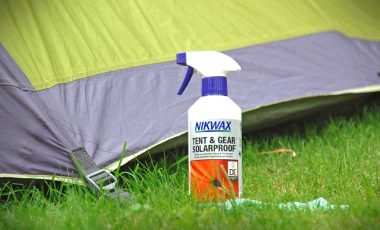When one of the main properties of tents is to keep the rain out, tent waterproofing seems like a strange thing to have to do. But even the highest quality camping tents will degrade over time and lose their effectiveness against the elements. So when the time comes to give your wilderness home from home a little spruce up, you’ll need to know what to do and how to waterproof a tent.
- Why do you need to waterproof a tent
- Identify the problem
- How to waterproof a tent
- The best waterproof tent sprays
- Canvas wataerproofing
- Tent waterproofing with a tarp
Why do you need to waterproof a tent
Although most half decent tents are waterproof when you buy them, there are some low grade tents out there that only claim water-resistance. These tents are by no means waterproof and will start melting at the first hint of moisture in the air. Well, not quite. But they certainly won’t provide enough protection when the wind whips up and rain starts pouring. Adding a tent waterproofing treatment to a tent such as this won’t make it waterproof, but it will improve its water-resistance.
Sun damage
Just like harmful UV rays can damage our skin, so too can it cause irreversible damage to fabrics that endure prolonged exposure to the sun. Even a couple of weeks’ camping in the summer sun can cause significant damage to the fly sheet of your tent, reducing its effectiveness to stand up to heavy rainfall. One of the best ways to prolong the life of your tent is to protect it from sun damage. If you camp in the sun lots then read on to see how to do this.
Use and age
Fabric that is constantly battered by the elements, covered in dirt and dust, left to dry out in the sun, then crumpled up in a bag and left for months, is going to deteriorate over time. This weather and dirt causes water to be absorbed into the fabric making it less effective against rain and wind. Applying tent waterproofing treatments help to prolong the life of the tent fabric by adding a DWR coating to the surface of the fabric. This makes the water bead and run off the fabric, preventing it from building up in one space and seeping through the fabric.
Damaged seams
Time and use out in the elements will also compromise the strength of the tent seams. Most tents come with fully sealed seams when you first buy them. But seals can break down over time causing leakages at the seams. Adding a seam sealant will solve this problem.
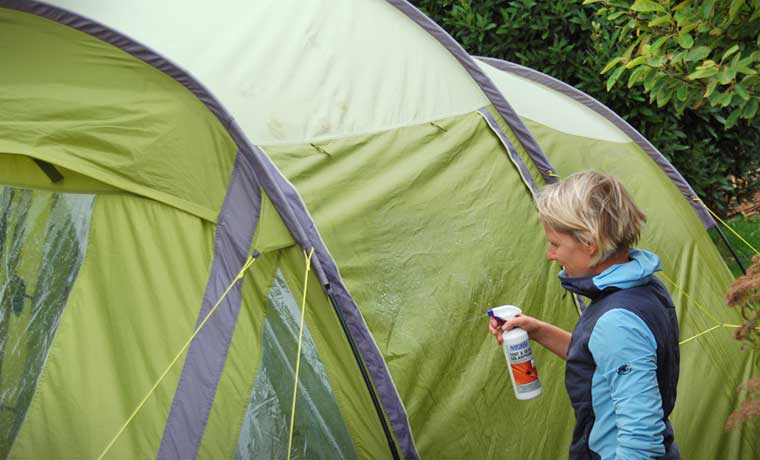
Identify the problem
Before you go covering the whole tent and all its seams in expensive tent waterproofing treatments, it’s a good idea to figure out which part of your tent is not doing its job properly. Asses your tent in the next rainstorm, or put it up in your backyard, douse it with water and look at the following things:
How to waterproof a tent
Some people routinely waterproof their tent after every few uses. Others may only embark upon tent waterproofing once in the tents’ lifetime! The frequency at which you waterproof your tent depends on how much you use it, how well you look after it, and in what conditions it gets used. We suggest at least once at year, at the beginning of the camping season.
01Clean your tent
Before applying a tent waterproofing treatment, seam sealant or repair tape, you’ll need to give your tent a good old clean.
- Set up your tent
- Fill a bucket with warm water and add some mild detergent or a tech wash
- Gently sponge down until it is clean, paying extra attention to the seams
- Apply tent waterproofing treatment before drying the tent
TOP TIP: Don’t put your tent in the washing machine.
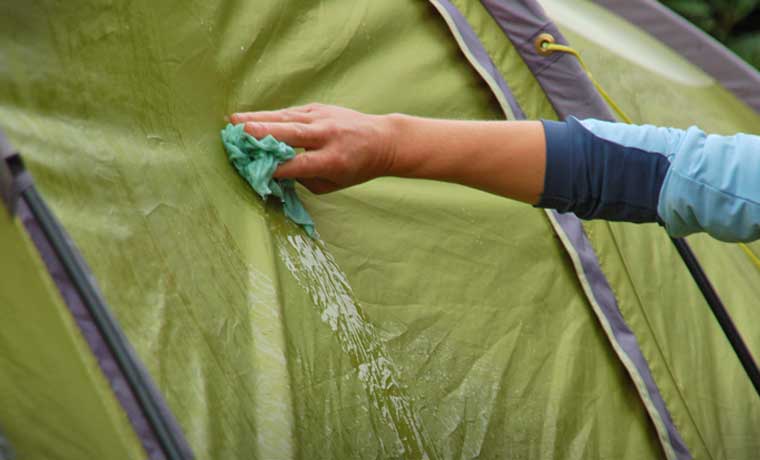
02Apply a tent waterproofing treatment
- Set up your tent
- Ensure that the tent is clean and wet
- Apply the treatment to the tent fly all over with a spray, brush or sponge
- Wipe off any excess product with a damp cloth
- Leave to dry fully before packing it away
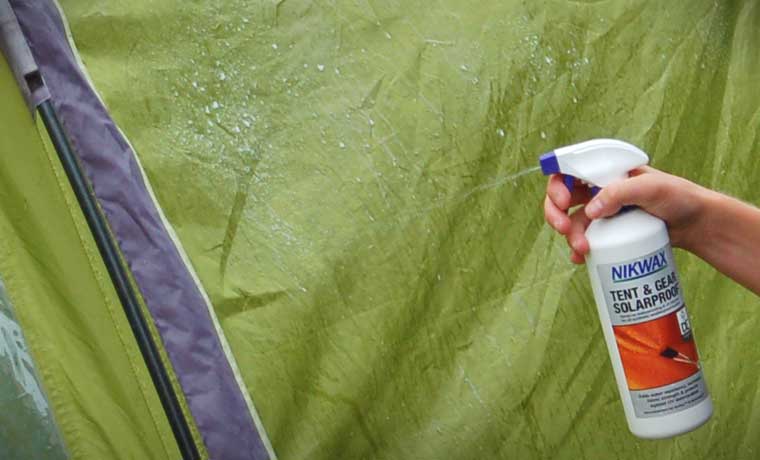
03Seal the seams
- Ensure that your tent is clean and dry
- Lay the tent out on a clean, flat space with the inside of the seams facing up
- Using a dry rag, wipe the seam with a small amount of rubbing alcohol to clean the fabric
- Carefully remove any bits that are peeling off
- Apply the seam sealant with a small brush as per the instructions
- Leave to dry fully before packing it away
The best waterproof tent sprays
There are a number of different tent waterproofing treatments available. Some combine tent wash with waterproof treatment. Others add UV protection. Here are some of the best options:
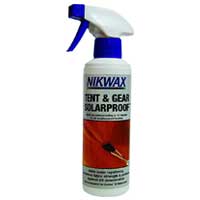
Nikwax Tent and Gear Solarproof
One of the best tent waterproofing methods is actually a preventative. This Solarproof treatment not only adds water repellency, but it also strengthens the fabric and protects against UV deterioration. This should be applied before you use your tent.
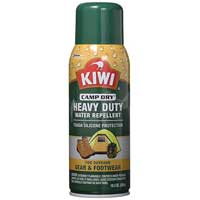
Kiwi Camp Dry Heavy Duty Water Repellent
Unlike the Nikwax products, this Kiwi Camp treatment is fairly chemical-filled. It needs two coats for best results, and can also be used on items other than tents.
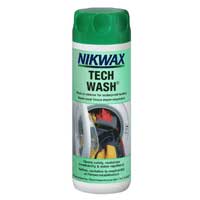
Nikwax Tech Wash
Although primarily a washing treatment for technical fabrics, Nikwax Tech Wash also revitalises breathability and water repellency. It is a good option to add some waterproofing as a preventative.
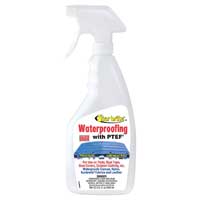
Star Brite Waterproofing Spray, Stain Repellent + UV Protection
This product is used in the same way as Nikwax Solarwash to protect your tent before you use it. However, it should be applied when the tent is dry, and it can also be used on a different items.
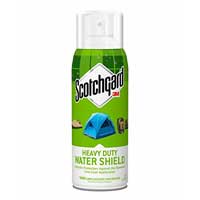
Scotchgard Outdoor Water Shield
This is a simple, one application waterproof tent spray that can also be used to add water repellency to other items of outdoor gear.
Canvas waterproofing
Some of the most luxurious and durable tents for camping and glamping are made with cotton canvas — bell tents or teepee tents perform very well in bad weather. This high performance is down to both the structural design, and the robustness of the canvas fabric. Cotton canvas relies on the natural properties of the fibers to create a highly weatherproof fabric that has been used by campers for centuries.
What’s important to note about canvas tents, however, is that you may find they leak a little the first few times they get rained on. This is not because they are faulty, but because the waterproofness of cotton canvas actually improves once it’s become wet. The cotton weave of the fabric tightens up once wet, effectively closing up all the tiny holes in the coarse fabric. So before you go splashing out on a pricey and time consuming canvas waterproofing treatment try getting your tent wet first!
TOP TIP FOR CANVAS WATERPROOFING: Pitch your tent in your backyard before you go camping and give it a good soaking with a hose pipe. Once it’s dried out it will be more waterproof.
Tent waterproofing with a tarp
If the idea of treating your tent with a chemical-based treatment isn’t for you, or if you’ve left tent waterproofing too late for your upcoming trip, then you can always add a waterproof tarp to your camping set up!
Pitch your tent as normal then rig up a tarp over the tent, ensuring that the whole tent is more than covered. Consider where the water from the tarp will be running down to, and keep this area free from gear or shoes etc.
Tent waterproofing may seem like a chore, but it will prolong the life of your tent by many years. It is so worth doing, and your efforts will save you some precious pennies, as well as preventing another unloved item from being ditched in landfill. For more tips on how to be a green camper, read our article on eco-friendly camping.
Disclaimer: We use affiliate links and may receive a small commission on purchases.


